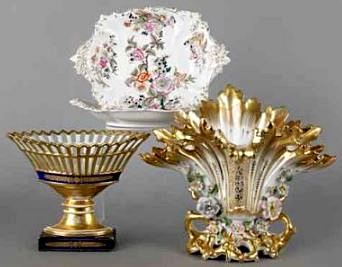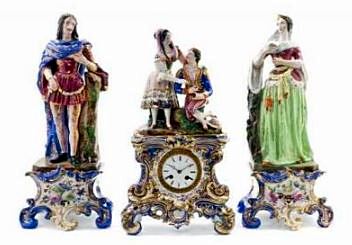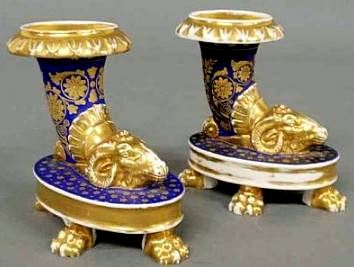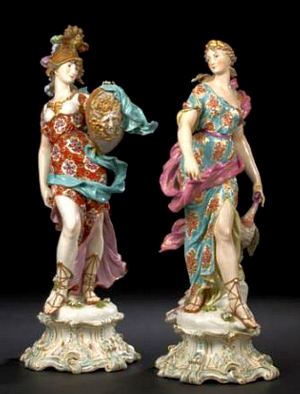PARIS PORCELAIN MARKS
Belle Epoque & French Aesthetic movement in Paris

Paris Porcelain – a term that conjures images of grandeur, elegance, and sophistication – is the collective name given to the various porcelain decorating workshops and studios within and around Paris, France. Unlike German marks that often replicate older Meissen marks, Paris Porcelain studios are known for their unique hand-painted or stamped logos that are quite distinct, although some are variations of the original crossed L’s mark used by Sevres.
From the mid-19th century to the present day, many Paris Porcelain studios have come and gone, but they are well documented. Marks used to identify porcelain from these workshops have been cataloged in specialized books and websites like our own marks4antiques.com that is always updated with even the latest fake marks on Asian imports in the same style.

One of the distinguishing features of Paris Porcelain is the painstakingly hand-decorated designs featuring floral or pastoral scenes in soft, pastel colors. The background is usually white or light blue. Furthermore, many porcelain items from Paris studios also have additional decorative details in materials other than ceramic, such as ormolu or metal overlay and mounts, usually in brass or bronze. Their size and scale can be described as “grand,” many of which are centerpieces for display only and have no utilitarian aspect to them whatsoever. Urns, large porcelain bowls, porcelain vases in pairs, or clock garnitures for the mantle are some of the most collectible examples. For this reason, the vast majority are well preserved, and it is rare to find pieces with any significant damage.
Paris Porcelain pieces are highly desired by collectors and are practically always part of an exhibit at many well-stocked museums. During the mid to late 19th century, following the French aesthetic movement during the reign of Napoleon’s descendants, many artisans flourished, creating pieces in the Greek or Neoclassical style that portray elegant and detailed depictions of mythological or ancient scenes. This fruitful period in the world of arts is commonly referred to as “Belle Epoque,” which literally means “Beautiful Era” in French. These pieces are usually signed by the individual artist who decorated them and also marked with the logo of the factory or kiln that produced the original blanks.

An exact address that includes the number and street of their location also accompanies the names of many Paris Porcelain workshops. Rue de Paradis-Poissonniere, Rue du Jour, and Rue de la Fontaine-au-Roi are common examples of names of streets in Paris that many of these workshops were situated. These studios often also operated as retailers to sell their wares. Because of the concentration of many of these in central Paris, these workshops also became a frequent stop for the well-to-do Parisians that wished to have porcelain centerpieces made to order as a gift for a loved one or to another noble family.
The Belle Epoque era in France saw a tremendous growth in the fine and decorative arts and a significant increase in the number of artisans following this French aesthetic movement. Paris Porcelain was an essential part of Belle Epoque, and the pieces created during this time are considered quintessential examples of the era's art.
Some notable Paris Porcelain studios whose works are very collectible and continue to appreciate in value include LAHOCHE & PANNIER - L' ESCALIER de CRISTAL ca 1840s - 1880s, LA MAISON ART NOUVEAU BING - GEORGES de FEURE ca 1880s - 1920s, MANUFACTURE de MADAME DUCHESSE d'ANGOULEME - P.L. DAGOTY AND E. HONORE'S FACTORY ca 1815 – 1822, E. JAQUEMIN [Fontaineblau] ca 1860s - 1880s, BAURY & VION ca 1845 - 1880s, BOURDOIS & BLOCH - ACHILLE BLOCH - ROBERT BLOCH - PORCELAINE DE PARIS ca 1829 – Present, and many others. It is estimated that more than 350 independent and separate studios operated in Paris at some time or another between the late 18th century to the present. Some also had connections or a separate studio in Limoges, and many blanks were purchased from factories there and decorated in Paris.

Edme Samson, who founded Samson Ceramique in 1845, was a well-known firm that made accurate replicas or reproductions of older porcelain well into the 1960s. In addition to their own unique marks, this company marked their items with symbols very similar to those seen on the actual original pieces they were copying. However, they added the letter "S" or some other sign to indicate that this was a copy. Items from the mid-to-late 19th century are valued today as high quality and considered essential for any serious collection of Paris Porcelain.
Paris Porcelain is known for its distinct quality, which characterizes it as hand-decorated in floral or pastoral scenes in soft and pastel colors. The background is typically white or light blue, and the pieces often have additional decorative details in materials other than ceramic, such as ormolu or metal overlay and mounts, usually in brass or bronze. The size and scale of these items can be described as "grand," with many being centerpieces for display only and having no utilitarian aspect to them. Examples of such items include urns, large porcelain bowls, porcelain vases in pairs, or clock garnitures for the mantle.
Antique Paris Porcelain pieces are highly sought after by collectors and are practically always part of an exhibit at many well-stocked museums. The makers are often obscure and unknown, or they may have created only a few pieces. However, many are from studios with a rich legacy of imperial financial support and patronage. They portray elegant and detailed depictions of mythological or ancient scenes, usually signed by the individual artist who decorated them and marked with the logo of the factory or kiln that produced the original blanks.
Values and prices at auction for Paris Porcelain vary significantly and depend on their size as well as their level of decorative detailing. Original 19th or early 20th century pieces fetch the most, especially if they are in great condition and have been identified properly. When purchasing Paris Porcelain, it is crucial to research the provenance, i.e., the history of ownership, as such historical context can be an important factor in its appraised valuation.
Unlock the true value
of your collection with our comprehensive research guides from identifying makers' marks to appraising all kinds of
antiques and collectibles.
Our up-to-date information will give you an accurate understanding of your items' worth. Don't miss out on this
valuable resource - visit our research tools today!
Search our price guide for your
own treasures





